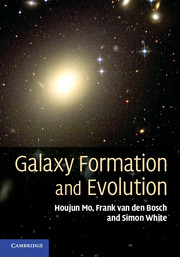Book contents
- Frontmatter
- Contents
- Preface
- 1 Introduction
- 2 Observational Facts
- 3 Cosmological Background
- 4 Cosmological Perturbations
- 5 Gravitational Collapse and Collisionless Dynamics
- 6 Probing the Cosmic Density Field
- 7 Formation and Structure of Dark Matter Halos
- 8 Formation and Evolution of Gaseous Halos
- 9 Star Formation in Galaxies
- 10 Stellar Populations and Chemical Evolution
- 11 Disk Galaxies
- 12 Galaxy Interactions and Transformations
- 13 Elliptical Galaxies
- 14 Active Galaxies
- 15 Statistical Properties of the Galaxy Population
- 16 The Intergalactic Medium
- A Basics of General Relativity
- B Gas and Radiative Processes
- C Numerical Simulations
- D Frequently Used Abbreviations
- E Useful Numbers
- References
- Index
7 - Formation and Structure of Dark Matter Halos
Published online by Cambridge University Press: 05 June 2012
- Frontmatter
- Contents
- Preface
- 1 Introduction
- 2 Observational Facts
- 3 Cosmological Background
- 4 Cosmological Perturbations
- 5 Gravitational Collapse and Collisionless Dynamics
- 6 Probing the Cosmic Density Field
- 7 Formation and Structure of Dark Matter Halos
- 8 Formation and Evolution of Gaseous Halos
- 9 Star Formation in Galaxies
- 10 Stellar Populations and Chemical Evolution
- 11 Disk Galaxies
- 12 Galaxy Interactions and Transformations
- 13 Elliptical Galaxies
- 14 Active Galaxies
- 15 Statistical Properties of the Galaxy Population
- 16 The Intergalactic Medium
- A Basics of General Relativity
- B Gas and Radiative Processes
- C Numerical Simulations
- D Frequently Used Abbreviations
- E Useful Numbers
- References
- Index
Summary
As we have seen in Chapter 2, there is ample evidence that galaxies reside in extended halos of dark matter. According to the current paradigm, these dark matter halos form through gravitational instability. As we have seen in Chapters 4 and 5, density perturbations grow linearly until they reach a critical density, after which they turn around from the expansion of the Universe and collapse to form virialized dark matter halos. These halos continue to grow in mass (and size), either by accreting material from their neighborhood or by merging with other halos. Some of these halos may survive as bound entities after merging into a bigger halo, thus giving rise to a population of subhalos. This process is illustrated in Fig. 7.1, which shows the formation of a dark matter halo in a numerical simulation of structure formation in a CDM cosmology. It shows how a small volume with small perturbations initially expands with the Universe. As time proceeds, small-scale perturbations grow and collapse to form small halos. At a later stage, these small halos merge together to form a single virialized dark matter halo with an ellipsoidal shape, which reveals some substructure in the form of dark matter subhalos.
In Chapter 6 we have described the overall statistical properties of the cosmic density field. In this chapter we focus on the statistical properties of the discrete halos, and on their internal structure.
- Type
- Chapter
- Information
- Galaxy Formation and Evolution , pp. 319 - 365Publisher: Cambridge University PressPrint publication year: 2010



